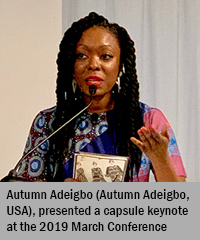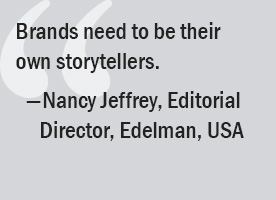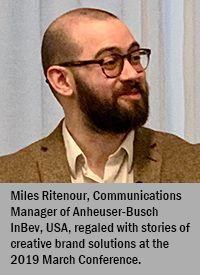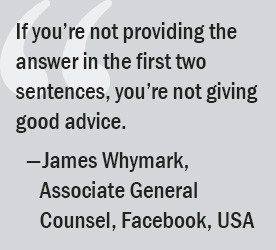Speaking the Same Language at INTA’s March Conference: The Business of Brands
Published: April 15, 2019
Ken Taylor Com Laude McLean, Virginia, USA
 More than 300 legal and brand professionals from 49 countries across five continents gathered March 28 and 29 to attend INTA’s 2019 March Conference: The Business of Brands in New York, New York, USA. Speakers took the discussion beyond trademarks, and focused on brands from a business perspective, encouraging registrants to learn-as INTA President David Lossignol (Novartis Pharma AG, Switzerland) put it-“to speak a common language in the workplace.”
More than 300 legal and brand professionals from 49 countries across five continents gathered March 28 and 29 to attend INTA’s 2019 March Conference: The Business of Brands in New York, New York, USA. Speakers took the discussion beyond trademarks, and focused on brands from a business perspective, encouraging registrants to learn-as INTA President David Lossignol (Novartis Pharma AG, Switzerland) put it-“to speak a common language in the workplace.”
Co-Chairs Deborah Davis (Electronic Arts, Inc., USA) and Judy McCool (HBO, USA) and their project team assembled a stellar group of speakers. Presenters included four CEOs; leaders in the fields of marketing, public relations, business, and legal professions; and fashion icon Stuart Weitzman.
Several sessions explored the challenges of legal and business partnerships to leverage intellectual property (IP) rights, while still keeping product launches, stakeholder communications, and brand reputation at the forefront. James Whymark, Associate General Counsel of Facebook, USA, shared the business team’s advice to him, saying, “If you’re not providing the answer in the first two sentences, you’re not giving good advice.”
There were also cautionary tales of proposed U.S. privacy regulations and the extra-territorial reach of the European Union’s General Data Protection Regulation from Linda Goldstein, Partner, BakerHostetler, USA, and Heidi Wachs, Vice President, Stroz
 Jeff Peters, Vice President, Licensing and Retail at HBO, raised the notion of today’s social media “culture of outrage” as a less-than-effective tool for interdepartmental
Jeff Peters, Vice President, Licensing and Retail at HBO, raised the notion of today’s social media “culture of outrage” as a less-than-effective tool for interdepartmental
This point was aptly illustrated by Miles Ritenour, Communications Manager of Anheuser-Busch InBev, USA. Mr. Ritenour explained that the company’s “Dilly Dilly” ad campaign was enthusiastically embraced by the public, garnering more Google searches than Beyoncé. But when a Minneapolis brewing company adopted “Dilly Dilly” as the name of their new IPA, Anheuser-Busch InBev decided it needed to protect its rights without “looking like the big bad beer giant.” So Mr. Ritenour and his legal team crafted a cease and desist order in Old English, mimicking the medieval theme of the ad campaign. A “town crier” visited the brewery and announced their (light-hearted) demands from a scroll.
Mr. Ritenour said he was inspired by Bryce Coughlin, Senior Counsel of Netflix, USA, whose now legendary cease and desist letter was sent in the language of the Netflix show Stranger Things to an unauthorized Chicago pop-up bar. Mr. Coughlin, who shared a panel with Mr. Ritenour and Andrea Anderson, Partner, Holland & Hart, USA, posed the question faced by in-house legal teams: “when do we care?” He suggested it was important to move the conversation from “what we can do” to “what we should do.” Ms. Anderson added that as outside counsel, dealing with “outrage” from a company to unauthorized use of their brand usually involves a lot of work in a compressed time, “not an atmosphere conducive to thoughtfulness.”
 Another topic discussed across the two days of the conference was how to manage legal issues versus business risks. “We used to be known as the ‘floor of no,’ said Cathy Lueders, Assistant General Counsel and Senior VP of MasterCard, USA. Rana Kardestuncer, Founder, January Communications, USA, said that, in her “former life,” marketing lived between “pushing the envelope and getting sued,” and that the mandate was “if legal says no, ignore them.” Ms. Lueders added, “business is the first line of defense, legal is the second line” and noted that it may be necessary to escalate “above junior-level execs who are sometimes only looking at the numbers.” Both Ms. Lueders and Ms. Kardestuncer agreed that core company values should always guide decisions on risk.
Another topic discussed across the two days of the conference was how to manage legal issues versus business risks. “We used to be known as the ‘floor of no,’ said Cathy Lueders, Assistant General Counsel and Senior VP of MasterCard, USA. Rana Kardestuncer, Founder, January Communications, USA, said that, in her “former life,” marketing lived between “pushing the envelope and getting sued,” and that the mandate was “if legal says no, ignore them.” Ms. Lueders added, “business is the first line of defense, legal is the second line” and noted that it may be necessary to escalate “above junior-level execs who are sometimes only looking at the numbers.” Both Ms. Lueders and Ms. Kardestuncer agreed that core company values should always guide decisions on risk.
The business-centric approach to issues followed through in the discussion of more traditional legal topics, such as the tax implications of IP transactions and ethics. Both Marc E. Berg of Feingold & Alpert, USA, and Larry Cohen of Cohen Law Firm, USA, respectively, provided a wealth of information with humor and passion.
Jennifer Leemann, Vice President, Internal Communications, Tapestry, USA, told the story of the evolution of Tapestry, in which “Coach” moved from being the company name of a stand-alone brand to being a brand within a “house of brands,” and Regina Thomas of Verizon, USA, described her experience of the transition from AOL, AOL and Yahoo, to Oath, and now Verizon Media. Both Ms. Leeman and Ms. Thomas shared their journeys to new corporate names and Ms. Leeman acknowledged that her company’s transition was relatively smooth compared to many companies attempting to negotiate similar changes.
 New to the conference this year were presentations by capsule keynote speakers, including Bess Freedman, CEO of Brown Harris Stevens, USA, who discussed New York City real estate; Nancy Jeffrey, Editorial Director, Edelman, USA, who stressed the importance of brand stories and how “brands need to be their own storytellers”; Autumn Adeigbo, Founder and CEO, Autumn Adeigbo, USA, who talked about ethical and sustainable
New to the conference this year were presentations by capsule keynote speakers, including Bess Freedman, CEO of Brown Harris Stevens, USA, who discussed New York City real estate; Nancy Jeffrey, Editorial Director, Edelman, USA, who stressed the importance of brand stories and how “brands need to be their own storytellers”; Autumn Adeigbo, Founder and CEO, Autumn Adeigbo, USA, who talked about ethical and sustainable
In a lively address, featured keynote Stuart Weitzman explained how he built the brand for the eponymous shoe company by inventing creative solutions to business roadblocks. Mr. Weitzman noted that thinking outside the box becomes more natural with
Overall, this year’s New York City conference highlighted the importance of members of the business and legal professions looking at issues from a different perspective, speaking the same language to build mutual trust in meeting business demands, enhancing consumer protection, and embracing change and innovation.
Although every effort has been made to verify the accuracy of items in the INTA Bulletin, readers are urged to check independently on matters of specific concern or interest.
© 2019 International Trademark Association
This website uses cookies so that we can provide you with the best user experience possible. Cookie information is stored in your browser and performs functions such as recognising you when you return to our website and helping our team to understand which sections of the website you find most interesting and useful.
To find out more please see our Cookies Policy and Privacy Policy.
These cookies are used to identify a user’s browser as the visitor goes from page to page on the Site. These are session cookies, which means that the cookie is deleted when you leave the Site. It is an integral piece of the Site software and used to let the server know which users are on the Site at any given time and make certain parts of the Site easier to use.
|
|
If you disable this cookie, we will not be able to save your preferences. This means that every time you visit this website you will need to enable or disable cookies again.
These cookies are used to collect information about how visitors use our Site. The cookies collect information in anonymous form, including the numbers of visitors to the Site, where visitors have come to the Site from, the pages they visited and how they have interacted with tools on the Site like search and embedded media players. We use the information to compile statistical reports of our users’ browsing patterns so that we can improve the Site.
|
|
Please enable Functionality Cookies first so that we can save your preferences!
These cookies are used to deliver advertising relevant to the interests of visitors to our Site. They are persistent, which means they will remain on your device after you leave the Site.
- Facebook (Ad Pixel)
- Google (Ad Pixel)
- LinkedIn (Ad Pixel)
- Quattro Anonymous
Please enable Functionality Cookies first so that we can save your preferences!
